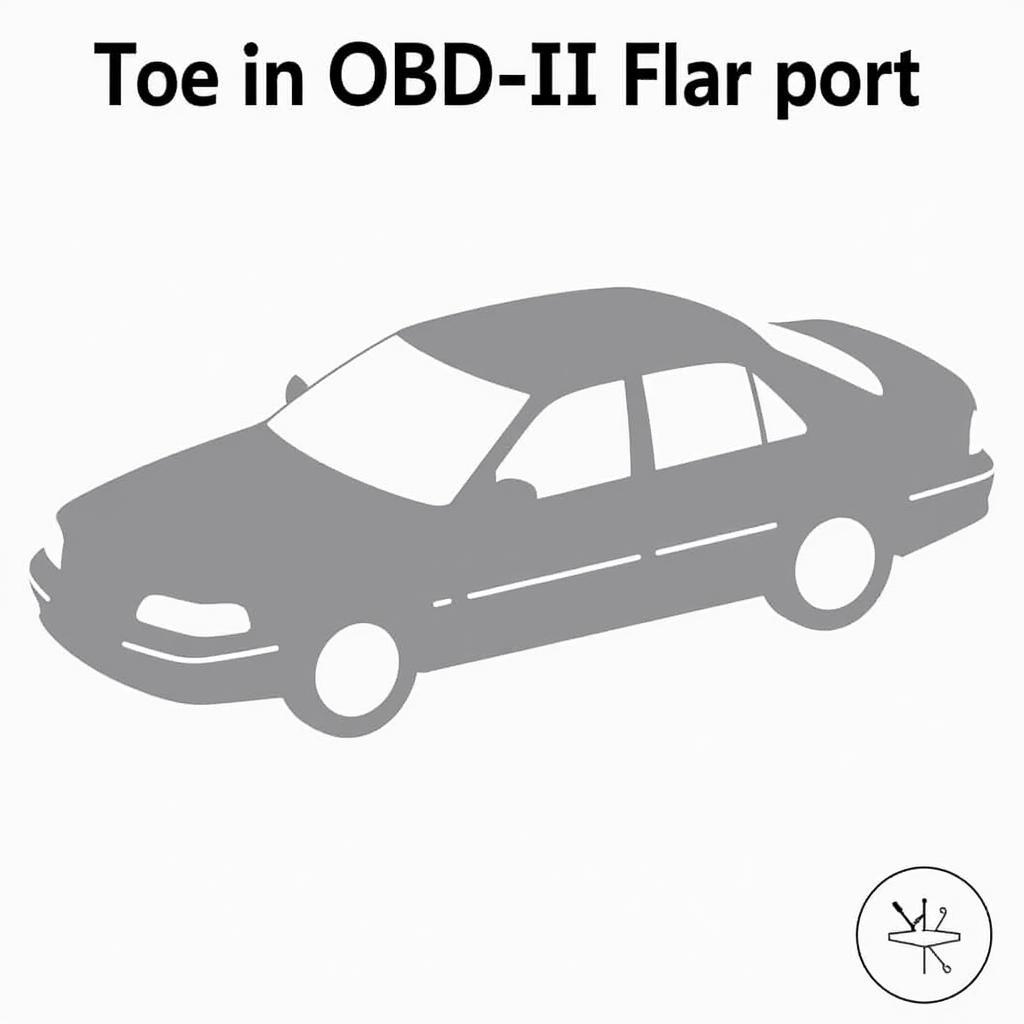In today’s tech-savvy world, car owners have access to powerful tools that can help them diagnose and even fix car problems. An Obdii/eobd Car Diagnostic Tool is one such tool. This guide will delve into the intricacies of these devices, providing you with the knowledge to understand and utilize them effectively.
What is an OBDII/EOBD Car Diagnostic Tool and Why Do You Need One?
[image-1|obd2-scanner-connected-to-car|Car with OBD2 Scanner Connected|A car’s dashboard lights up while an OBD2 scanner is plugged in under the steering wheel. This setup is used to diagnose car problems and understand the vehicle’s health.]
An OBDII/EOBD (On-Board Diagnostics, second generation/European On-Board Diagnostics) car diagnostic tool is like a window into your car’s computer system. It allows you to communicate with your vehicle, retrieve diagnostic trouble codes (DTCs), and monitor various parameters in real-time. But why is this important?
Imagine this: Your check engine light illuminates, striking fear into your heart. Traditionally, this meant an expensive trip to the mechanic, uncertain of the issue. With an OBDII/EOBD scanner, you can read the DTC yourself, instantly understanding the problem. This knowledge empowers you to:
- Save Money: Diagnose problems yourself and potentially avoid costly mechanic visits for minor issues.
- Save Time: Identify issues quickly without relying on a mechanic’s schedule.
- Gain Control: Understand your car’s health and make informed decisions about maintenance and repairs.
- Improve Performance: Monitor engine parameters and optimize your car’s performance.
How OBDII/EOBD Scanners Work: Decoding the Mystery
Modern vehicles come equipped with an Electronic Control Unit (ECU), essentially the car’s brain. When a problem arises, the ECU logs a DTC, which is like a coded message about the issue. The OBDII/EOBD port, usually located under the steering wheel, acts as the communication point.
[image-2|mechanic-using-obd2-scanner|Mechanic Using OBD2 Scanner on a Car|A mechanic leans over the open hood of a car and uses a professional OBD2 scanner. The mechanic is analyzing the data displayed on the scanner screen to diagnose a potential problem.]
The scanner plugs into this port and acts as a translator, converting the complex codes into understandable information. This information can range from simple issues like a loose gas cap to more complex engine or transmission problems.
Types of OBDII/EOBD Car Diagnostic Tools: Finding the Right Fit for You
Just like cars themselves, OBDII/EOBD scanners come in different shapes and sizes, each catering to specific needs:
- Basic Code Readers: These entry-level scanners are budget-friendly and can read and clear basic DTCs. Ideal for DIY enthusiasts who want to understand the “check engine” light.
- Advanced Scan Tools: Offering a broader range of features, these scanners provide live data stream readings, allowing you to monitor engine parameters like RPM, temperature, and oxygen sensor readings. Some even offer ABS and airbag system diagnostics.
- Professional Scan Tools: Primarily used by mechanics and professional technicians, these tools offer comprehensive diagnostic capabilities, including advanced programming functions, bi-directional control, and access to manufacturer-specific codes.
The ms309 can diagnostic scan tool for obdii vehicles is an example of a versatile scanner that caters to a wide range of needs, striking a balance between features and affordability.
Choosing the Right OBDII/EOBD Scanner: Factors to Consider
With numerous options available, choosing the right OBDII/EOBD scanner can seem overwhelming. Consider these factors to make an informed decision:
- Your Budget: Prices vary widely, so determine your spending limit beforehand.
- Your Skill Level: Basic code readers are suitable for beginners, while advanced users might require more sophisticated tools.
- Your Vehicle’s Make and Model: Some scanners are designed for specific makes and models, offering enhanced functionality.
- Desired Features: Consider the features you need, such as live data streaming, ABS diagnostics, or manufacturer-specific code reading.
For those seeking a feature-rich yet user-friendly option, the creader 4001 diagnostic scan tool offers a compelling package that caters to both DIY enthusiasts and professionals.
The Power in Your Hands: Benefits of Owning an OBDII/EOBD Scanner
Owning an OBDII/EOBD car diagnostic tool is akin to having a personal mechanic at your fingertips. It empowers you with the knowledge to:
- Diagnose problems accurately: Eliminate guesswork and identify the root cause of car troubles.
- Monitor car health proactively: Track engine parameters and detect potential issues before they escalate.
- Negotiate fairly with mechanics: Armed with knowledge, you can engage in more informed discussions and avoid unnecessary repairs.
- Enhance your car knowledge: Learn about your vehicle’s inner workings and gain valuable mechanical insights.
“As a seasoned mechanic, I’ve seen firsthand how OBDII/EOBD scanners empower car owners. They’re no longer in the dark when their check engine light comes on. It’s about transparency and giving people the tools to understand their vehicles.” – John Miller, Certified Master Mechanic
Conclusion
OBDII/EOBD car diagnostic tools have revolutionized car maintenance and repair. These powerful devices empower car owners and mechanics alike with the knowledge to diagnose problems accurately, save time and money, and ultimately take control of their vehicles. Whether you’re a DIY enthusiast or a professional technician, investing in the right OBDII/EOBD scanner is a smart decision that will pay dividends for years to come.
Need help choosing the right OBDII/EOBD scanner for your needs? Contact ScanToolUS at +1 (641) 206-8880 or visit our office at 1615 S Laramie Ave, Cicero, IL 60804, USA. We’re here to help you keep your car running smoothly!



Pingback: OBDII EOBD Car Diagnostic Tool: The Mechanic in Your Pocket - Car Scan Tool